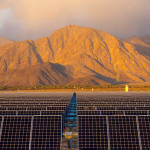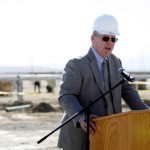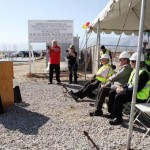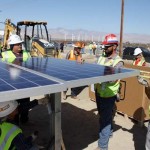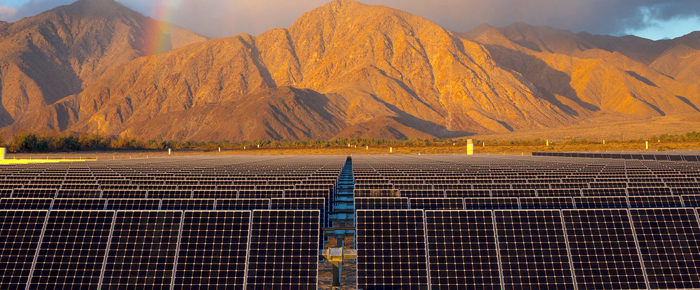
By Heidi Simmons
For many, the joy of year-round sunshine is why we live here in the Coachella Valley. And for that very reason, the CV is becoming the hot spot for solar farms. With wind and solar, the valley is now producing more renewable kilowatt-hours than any other place in the country!
The latest addition is the 2.9 megawatt solar energy system off Dillon Road in Desert Hot Springs — the city’s first large distributed generation solar project. Set on 14.4 acres, the grid-tied solar photovoltaic system will contribute over 6,000 megawatt hours (or six million kilowatt hours) of clean energy annually to the utility grid. That is the equivalent to planting 3642 acres of forest, or removing 926 cars off the road, or providing 611 single-family homes with energy for a year. Considered small distributive generation, the solar energy produced is used to directly aid or offset the existing load on the grid enhancing stability across the region and throughout state.
The project, which began in 2011, is expected to be on line before the end of the year. Privately owned and funded by New York based ConEdison Solutions, the estimated cost of building the solar farm is eight million dollars. ConEdison has a power purchase agreement with Southern California Edison for 20 years, which is the minimum life expectancy of the farm.
Solar panels work when the photovoltaic cells capture electrons from the sun and convert them to energy. The solar farm is divided into 20 sections with a total of 10,000 solar modules on racks mounted with pylons buried five to eight feet deep in the soil. The panels are set with an automated single-axis tracking system, which follows the sun from its rising in the east, to its setting in the west, or 0 to 45 degrees. There are 221 rows with 26 combiner points similar to a household electrical panel. The energy is then combined and inverted from direct current (DC) to alternating current (AC). Two transformer pads directly feed the energy into the grid. This electricity is then used by local residents and businesses.
Solar production is 20 percent less in the winter due to the angle of the sun and potential cloud cover. The photovoltaic panels are cleaned twice a year. The system is electronically monitored for efficiency and damage around the clock but requires no personnel on site.
At the recent construction celebration, Desert Hot Springs Mayor, Yvonne Parks said, “This project is a vital piece of the economic rebirth for the city of Desert Hot Springs. This project confirms our team can successfully entitle and permit a new use for industrial land and begins to open up our Dillon Industrial Corridor.” Parks went on to say the sales tax from the project would provide essential services that directly benefit the community.
Riverside County supervisor John Benoit said, “Eastern Riverside County is the largest Federal solar energy zone in the country. It’s remarkable to see renewable energy showcased in our natural setting being utilized.” He added there are some holdups that include the need for additional transmission and that financing has been a problem, but was encouraged by the success of the Desert Hot Springs solar project.
Rebekah Rodriguez-Lynn, Deputy District Director for US Congressman Ruiz said the Congressman was thrilled with the jobs and clean renewable energy being created by the project. Lynn said that Ruiz is on the House Committee on Natural Resources and has asked the House Committee on Ways and Means to do a tax restructuring to give more credits to renewable energy. She added that Ruiz has backed an initiative to get money for green jobs training as well.
Borrego Solar Systems, Inc. played an integral part in the development of the property and project. Besides the design and installation of the solar system, they helped obtain financing and led the building and approval process. Established in nearby Borrego Springs in 1980, the company has since completed 1,000 solar power installations totaling nearly 90 megawatts across the country. Borrego Solar headquarters are now in San Diego.
Nina McCullough the local Public Affairs Regional Manager for Southern California Edison and a board member on the Desert Hot Springs Chamber of Commerce said the project was part of a program with Southern California Edison called CREST — California Renewable Energy Small Tariff which provides standardized fixed price energy payments to qualifying renewable energy generators of 1.5 megawatts or less in their service and distribution territory.
The Desert Hot Springs solar project has two CREST contracts for one megawatt and 1.5 megawatt. Although the CREST program is now closed, the DHS facility is one of the first to come on line. McCullough said, “This project will provide clean power to SCE customers and help meet the renewable portfolio standards of 33 percent renewable.”
The Desert Hot Springs Chamber of Commerce hosted the event. Heather Coladonato, President/CEO of the Chamber said, “The chamber is excited for this solar project, along with future corridor projects, as they continue to create jobs and generate additional tax revenue in the city.”
Desert Hot Springs is on the sunny side of the valley and the city’s outlook on renewable energy appears very bright indeed.


































